
The EU has approved the first mixed reality flight simulator designed for pilot training.
For the first time, the European Union Aviation Safety Agency (EASA) has certified a mixed reality (MR) headset for civil aviation training, possibly indicating a transformation in pilot education.
Developed by Finnish startup Varjo, the headset, known as XR-4, replaces the smaller, more affordable screens typically found in flight training cockpits that are used during the final stages of pilot training, which are essentially scaled-down versions of full-flight simulators.
This MR technology combines digital environments with the actual cockpit and the pilot's hands and body. Through a method called "masking," the surroundings outside the cockpit are digitally created, while the trainee engages with real cockpit controls.
The hybrid system aims to create an authentic flying experience for pilots. It also features eye-tracking capabilities that allow instructors to monitor where trainees are looking, helping them assess student responses during high-stress situations such as landings in low visibility or engine failures.
Varjo's headset has been incorporated into a new flight trainer by Swiss simulation device manufacturer Brunner Elektronik, which mimics the interior of a Diamond DA42 aircraft. EASA’s certification grants formal authorization to record civilian flight hours in Europe, and Lufthansa’s flight academy in Munich is already utilizing this technology for training its new recruits.
“This is much more than a one-off tech trial,” stated Tristan Cotter, Varjo’s global head of defence and aerospace, in an interview with TNW. “It represents the launch of the first qualified mixed reality simulator that we believe is on a definite path toward broader regulatory approvals.”
Founded in 2016, Varjo has raised over $200 million and is recognized as Europe’s most well-funded XR scaleup. Although it has previously collaborated with military and industrial clients, this is its first system approved for civilian pilot training.
While Cotter sees the potential for MR to change pilot training, he acknowledges the existing limitations of the technology. “Mixed reality isn’t set to replace full-flight simulators in the near future,” he noted. “However, it has significant potential to influence the earlier stages of pilot education."
EASA’s certification emerges amidst increasing initiatives to incorporate extended reality (XR) tools into regulated sectors. The UK's National Health Service (NHS) has tested VR headsets for surgical training, Rolls-Royce has applied MR for aircraft engine maintenance, and EDF Energy has used the technology to train technicians at its nuclear plants.
Nevertheless, a recent report by research and advisory firm Forrester suggests that the broader adoption of industrial XR has been slower than anticipated.
James McQuivey, a principal analyst at Forrester, attributed this sluggish uptake to “high costs and a lack of compelling use cases,” advising organizations to “adjust their expectations.”
Nonetheless, the report indicates that training is an area where the technology has already shown a clear return on investment.
If you're eager to learn about the next significant innovations in technology, consider attending the TNW Conference, where thousands of founders, investors, and corporate innovators will share their insights. The event is scheduled for June 19–20 in Amsterdam, and tickets are available now. Use code TNWXMEDIA2025 for a 30% discount at checkout.

Other articles
 Klarna's CEO: Engineers may fall behind business professionals with coding skills.
Sebastian Siemiatkowski states that the quickest achievers at Klarna are not conventional engineers, but rather business individuals who have acquired coding skills.
Klarna's CEO: Engineers may fall behind business professionals with coding skills.
Sebastian Siemiatkowski states that the quickest achievers at Klarna are not conventional engineers, but rather business individuals who have acquired coding skills.
 TNW Backstage interviews the founder who transformed flower delivery.
This week on TNW Backstage, the guest is Aron Gelbard, co-founder and CEO of Bloom & Wild, which is the highest-rated online flower delivery service in the UK.
TNW Backstage interviews the founder who transformed flower delivery.
This week on TNW Backstage, the guest is Aron Gelbard, co-founder and CEO of Bloom & Wild, which is the highest-rated online flower delivery service in the UK.
 Tech executives criticize "incredibly toxic" demands for seven-day work weeks.
Venture capitalists encouraging startup founders to put in seven days of work each week are encountering criticism from European tech leaders, who label the notion as "toxic" and "childish."
Tech executives criticize "incredibly toxic" demands for seven-day work weeks.
Venture capitalists encouraging startup founders to put in seven days of work each week are encountering criticism from European tech leaders, who label the notion as "toxic" and "childish."
 Behind the surge of blind boxes: the worldwide rise of Pop Mart’s Labubu
On Tuesday, Pop Mart's shares reached an all-time high, elevating its market capitalization to over HK$310 billion ($39.7 billion) following an increase of more than 160% this year.
Behind the surge of blind boxes: the worldwide rise of Pop Mart’s Labubu
On Tuesday, Pop Mart's shares reached an all-time high, elevating its market capitalization to over HK$310 billion ($39.7 billion) following an increase of more than 160% this year.
The EU has approved the first mixed reality flight simulator designed for pilot training.
For the first time, the European Union Aviation Safety Agency (EASA) has approved a mixed reality headset for training in civil aviation.
